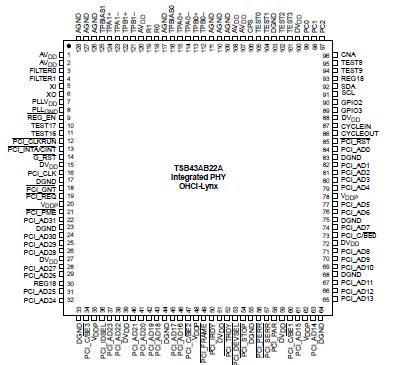Features: • Fully compliant with provisions of IEEE Std 1394-1995 for a high-performance serial bus† and IEEE Std 1394a-2000
• Fully interoperable with FireWire and i.LINK implementations of IEEE Std 1394
• Compliant with Intel Mobile Power Guideline 2000
• Full IEEE Std 1394a-2000 support includes: connection debounce, arbitrated short reset, multispeed concatenation, arbitration acceleration, fly-by concatenation, and port disable/suspend/resume
• Power-down features to conserve energy in battery-powered applications include: automatic device power down during suspend, PCI power management for link-layer, and inactive ports powered down
• Ultralow-power sleep mode
• Two IEEE Std 1394a-2000 fully compliant cable ports at 100M bits/s, 200M bits/s, and 400M bits/s
• Cable ports monitor line conditions for active connection to remote node
• Cable power presence monitoring
• Separate cable bias (TPBIAS) for each port
• 1.8-V core logic with universal PCI interfaces compatible with 3.3-V and 5-V PCI signaling environments
• Physical write posting of up to three outstanding transactions
• PCI burst transfers and deep FIFOs to tolerate large host latency
• PCI_CLKRUN protocol
• External cycle timer control for customized synchronization
• Extended resume signaling for compatibility with legacy DV components
• PHY-Link logic performs system initialization and arbitration functions
• PHY-Link encode and decode functions included for data-strobe bit level encoding
• PHY-Link incoming data resynchronized to local clock
• Low-cost 24.576-MHz crystal provides transmit and receive data at 100M bits/s, 200M bits/s, and 400M bits/s
• Node power class information signaling for system power management
• Serial ROM interface supports 2-wire serial EEPROM devices
• Two general-purpose I/Os
• Register bits give software control of contender bit, power class bits, link active control bit, and IEEE Std 1394a-2000 features
• Fabricated in advanced low-power CMOS process
• PCI and CardBus register support
• Isochronous receive dual-buffer mode
• Out-of-order pipelining for asynchronous transmit requests
• Register access fail interrupt when the PHY SCLK is not active
Pinout Description
Description
The Texas Instruments TSB43AB22A device is an integrated 1394a-2000 OHCI PHY/link-layer controller (LLC) device that is fully compliant with the PCI Local Bus Specification, the PCI Bus Power Management Interface Specification, IEEE Std 1394-1995, IEEE Std 1394a-2000, and the 1394 Open Host Controller Interface Specification. It is capable of transferring data between the 33-MHz PCI bus and the 1394 bus at 100M bits/s, 200M bits/s, and 400M bits/s. The TSB43AB22A device provides two 1394 ports that have separate cable bias (TPBIAS). The TSB43AB22A device also supports the IEEE Std 1394a-2000 power-down features for battery-operated applications and arbitration enhancements.
As required by the 1394 Open Host Controller Interface Specification (OHCI) and IEEE Std 1394a-2000, internal control registers are memory-mapped and nonprefetchable. The PCI configuration header is accessed through configuration cycles specified by PCI, and it provides plug-and-play (PnP) compatibility. Furthermore, the TSB43AB22A device is compliant with the PCI Bus Power Management Interface Specification as specified by the PC 2001 Design Guide requirements. The TSB43AB22A device supports the D0, D1, D2, and D3 power states.
The TSB43AB22A design provides PCI bus master bursting, and it is capable of transferring a cacheline of data at 132M bytes/s after connection to the memory controller. Because PCI latency can be large, deep FIFOs are provided to buffer the 1394 data.
The TSB43AB22A device provides physical write posting buffers and a highly-tuned physical data path for SBP-2 performance. The TSB43AB22A device also provides multiple isochronous contexts, multiple cacheline burst transfers, advanced internal arbitration, and bus-holding buffers.
An advanced CMOS process achieves low power consumption and allows the TSB43AB22A device to operate at PCI clock rates up to 33 MHz.
The TSB43AB22A PHY-layer provides the digital and analog transceiver functions needed to implement a two-port node in a cable-based 1394 network. Each cable port incorporates two differential line transceivers. The transceivers include circuitry to monitor the line conditions as needed for determining connection status, for initialization and arbitration, and for packet reception and transmission.
The TSB43AB22A PHY-layer requires only an external 24.576-MHz crystal as a reference for the cable ports. An external clock may be provided instead of a crystal. An internal oscillator drives an internal phase-locked loop (PLL), which generates the required 393.216-MHz reference signal. This reference signal is internally divided to provide the clock signals that control transmission of the outbound encoded strobe and data information. A 49.152-MHz clock signal is supplied to the integrated LLC for synchronization and is used for resynchronization of the received data.
Data bits to be transmitted through the cable ports are received from the integrated LLC and are latched internally in synchronization with the 49.152-MHz system clock. These bits are combined serially, encoded, and transmitted at 98.304M, 196.608M, or 393.216M bits/s (referred to as S100, S200, or S400 speeds, respectively) as the outbound data-strobe information stream. During transmission, the encoded data information is transmitted differentially on the twisted-pair B (TPB) cable pair(s), and the encoded strobe information is transmitted differentially on the twisted-pair A (TPA) cable pair(s).
During packet reception, the TPA and TPB transmitters of the receiving cable port are disabled, and the receivers for that port are enabled. The encoded data information is received on the TPA cable pair, and the encoded strobe information is received on the TPB cable pair. The received data-strobe information is decoded to recover the receive clock signal and the serial data bits. The serial data bits are resynchronized to the local 49.152-MHz system clock and sent to the integrated LLC. The received data is also transmitted (repeated) on the other active (connected) cable ports.

 TSB43AB22A Data Sheet
TSB43AB22A Data Sheet








